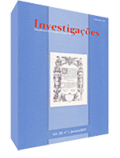Le Tebeo Espagnol
Abstract
Parece muito difícil falar de desenho em quadrinhos sem examinar o querepresenta o tebeo para os espanhóis. Este termo não é uma traduçãoespanhola de desenho em quadrinhos. Ele designa antes de tudo umsuporte de desenhos em quadrinhos destinados às crianças aparecido navirada dos anos vinte do século XX. Este artigo examina o tebeo — únicamídia de massa accessível em uma Espanha isolada após a Guerra Civil(1936–1939) —, enquanto fenômeno editorial, social e cultural (anos 70e 80).References
Antonio Altarriba, La España del tebeo, La Historieta Española de 1940 a 1970, Madrid,Espasa Calpe, Ensayo y pensamiento, 200, p. 11-23.
Chicos. Semanario infantil, 1938-1956, El arte en viñetas, catalogue d’exposition, Commissaire. Antonio de Mateo Remacha, sin sentido, 2002, p. 13-17.
“Deontología del periodista en publicaciones infantiles y juveniles”, Curso deprensa infantil, Escuela Oficial de Periodismo, Madrid, 1964.
José Antonio Ramírez, El cómic femenino en España, Madrid, Cuadernos para el diálogo, 1975.
Jesús Cuadrado, Atlas de la cultura popular, de la Historieta y su uso, 1873-2000, Madrid, ed. sin sentido, Fundación Germán Sánchez Ruipérez, 2000.
Luis Gasca, Los héroes de papel, Táber-Epos, 1969.
Pedro Porcel, La historia del tebeo valenciano, Alicante, ed. De Ponent, 2002.
Salvador Vázquez de Parga, Los tebeos de aventuras en 200 portadas,
Barcelona, Glenat, 1999.
Downloads
Published
How to Cite
Issue
Section
License
Copyright (c) 2007 Viviane Alary

This work is licensed under a Creative Commons Attribution 4.0 International License.
Authors who publish with Revista Investigações agree to the following terms:
Authors retain copyright and grant the journal right of first publication with the work simultaneously licensed under the Creative Commons Attribution 4.0 International (CC BY 4.0) license that allows others to share the work with an acknowledgement of the work's authorship and initial publication in this journal.
Authors are able to enter into separate, additional contractual arrangements for the non-exclusive distribution of the journal's published version of the work (e.g., post it to an institutional repository or publish it in a book), with an acknowledgement of its initial publication in this journal.
You are free to:
Share — copy and redistribute the material in any medium or format for any purpose, even commercially.
Adapt — remix, transform, and build upon the material for any purpose, even commercially.
The licensor cannot revoke these freedoms as long as you follow the license terms.
Under the following terms:
Attribution — You must give appropriate credit , provide a link to the license, and indicate if changes were made . You may do so in any reasonable manner, but not in any way that suggests the licensor endorses you or your use.
No additional restrictions — You may not apply legal terms or technological measures that legally restrict others from doing anything the license permits.

